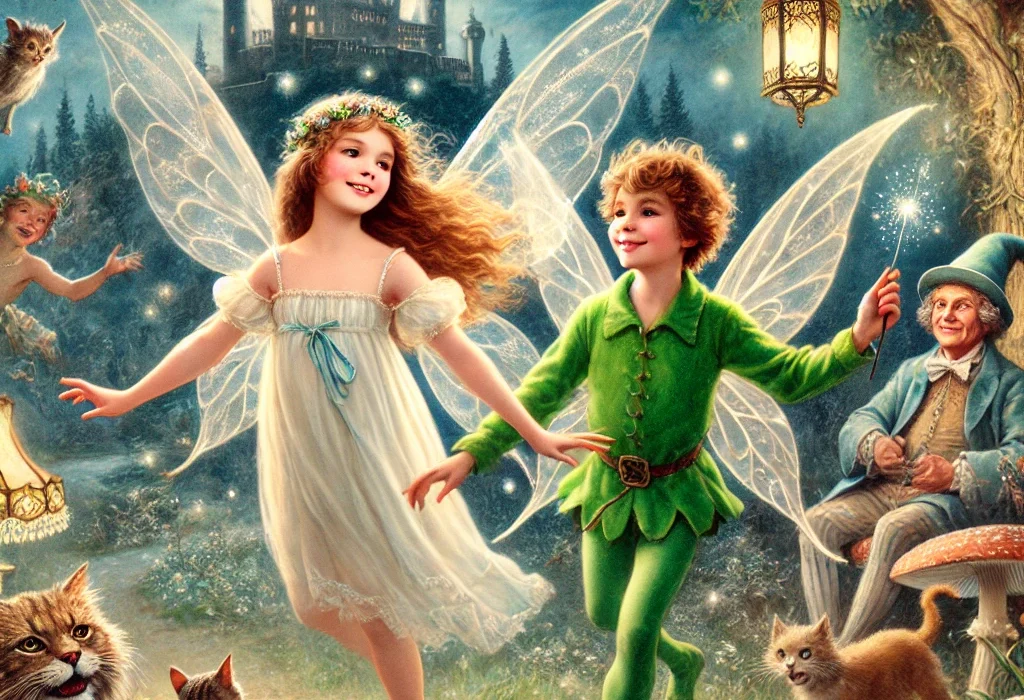Sylvie and Bruno, written by Lewis Carroll and published in 1889, is a complex narrative blending elements of fantasy, satire, and philosophical musings. The story unfolds in two parallel realms: one is a whimsical fairy world inhabited by Sylvie and Bruno, and the other is a more realistic Victorian society. Carroll, best known for Alice’s Adventures in Wonderland, uses this book to delve into themes of innocence, social critique, and the philosophical questions of life. Through Sylvie, Bruno, and a colorful array of characters, Carroll weaves a tale filled with humor, moral lessons, and reflections on human nature.
Plot Summary
In a faraway land, in the quiet yet enchanted kingdom of Outland, a crowd gathered noisily in the marketplace, shouting contradictory demands. Some yelled for bread, others for taxes, but none seemed to know exactly what they wanted. Overlooking the scene from a window of the palace was the Warden, a kind and wise man, and his loyal Lord Chancellor. The chaos outside was nothing compared to the schemes brewing within the palace walls, for the Warden’s younger brother, the cunning Sub-Warden, alongside his ambitious wife, My Lady, had plans of their own.
Sylvie, the Warden’s sweet and compassionate daughter, and her mischievous younger brother Bruno, lived in this strange world, where human and fairy realms intertwined. Sylvie was gentle and thoughtful, always taking care of Bruno, who, though full of energy and mischief, adored his sister. Together, they navigated the oddities and challenges of their world, unaware of the sinister plots unfolding around them.
The Sub-Warden and My Lady, hungry for power, dreamed of overthrowing the Warden. The Sub-Warden was sly and deceitful, and his wife, even more so, encouraged him to manipulate the kingdom’s affairs to their benefit. They longed for riches, and in their hearts, they harbored the ambition of ruling as Emperor and Empress. But their plans required secrecy, and the Warden, unaware of their treachery, trusted his brother with the kingdom’s affairs in his absence.
The Warden prepared to leave on a journey, handing over his duties to the Sub-Warden in good faith. Yet, as soon as the Warden was out of sight, the Sub-Warden’s true nature emerged. Together with the Lord Chancellor, who had now revealed himself as an accomplice, the Sub-Warden altered the agreements and laws to secure his authority over the land. They planned to seize the treasures of the kingdom and deceive the people, slowly shifting the power into their hands.
Meanwhile, Sylvie and Bruno continued their innocent play in the castle, unaware of the dangerous web being spun around them. Bruno, though a troublemaker, always found solace in Sylvie’s kindness, and the two shared a deep bond that kept them joyful even as shadows loomed over their lives. As they wandered through the palace gardens and played in their secret spots, Bruno, with his bright eyes and ever-curious nature, looked up to Sylvie for guidance and wisdom.
Their world, however, was not without its oddities. One day, Bruno encountered the peculiar Professor, a jolly man prone to strange inventions and unusual insights. The Professor, a friend of the Warden, was a figure of great knowledge, though often distracted by his unusual inventions and ideas. On one such occasion, he introduced Bruno to a bizarre “plunge-bath” device, a curious contraption meant to conserve water while giving one a full bath. Bruno, bewildered and amused, quickly realized that the Professor’s creations, while ingenious, rarely worked as intended.
Yet, beyond these innocent distractions, darker events were in motion. The Sub-Warden, with My Lady’s encouragement, began conspiring to spread rumors of the Warden’s death. Their plan was to convince the people that the Warden had perished during his travels, paving the way for the Sub-Warden to officially claim the throne. My Lady, ever eager to indulge in luxury and power, dreamed of wearing the kingdom’s jewels and driving the coach-and-four through the streets of Outland. They would claim the wealth and rule as Emperor and Empress, crushing any opposition that stood in their way.
As these schemes unfolded, an old beggar appeared at the palace gates, pleading for food and shelter. He was a man of dignity and wisdom, though worn by age and hardship. Sylvie, moved by compassion, wished to help him, but the cruel Uggug, the spoiled son of the Sub-Warden and My Lady, taunted the beggar mercilessly, pouring water over him and shouting insults. Uggug’s brutishness knew no bounds, and his parents, rather than disciplining him, praised his wicked behavior. Bruno, heartbroken by the sight, wanted to give the beggar his own slice of plum cake, but Sylvie held him back, knowing it was too dangerous to act openly in front of Uggug’s parents.
Despite the growing tension, Sylvie and Bruno’s bond remained unshaken. As the days passed, they spent their time exploring the castle and its surroundings, seeking solace in their companionship. Sylvie’s calm demeanor always balanced Bruno’s exuberant energy, and together, they faced whatever strange events came their way. The pair often ventured into the fairy realm, where magical creatures and beings provided respite from the looming threats of the human world. In this enchanted land, Sylvie and Bruno were free from the worries that troubled their kingdom.
The Vice-Warden, however, was not satisfied with mere whispers of power. He and My Lady were ready to escalate their plans, calling for an election that would grant them the title of Emperor and Empress. They cared little for the well-being of the people, who had already begun to suffer from the harsh new taxes and the closure of the bakeries. The people’s cries for “More bread, less taxes” fell on deaf ears, as the Vice-Warden sought only to enrich himself at their expense.
Yet, even as their schemes progressed, Sylvie and Bruno’s innocence and love for one another remained a beacon of hope in the darkening world. They could not understand the complexities of the adult world around them, but their pure hearts and unwavering bond shielded them from the worst of the evil encroaching upon their lives. The day would soon come when Sylvie’s compassion and Bruno’s bravery would be tested in ways they could not yet imagine, but for now, they continued to laugh, play, and dream, untouched by the darkness lurking just beyond the horizon.
In this magical and peculiar kingdom, where fantasy and reality intertwined, love and innocence stood as the last defense against greed, corruption, and the relentless pursuit of power.
Main Characters
Sylvie: A sweet and compassionate fairy, Sylvie is the central figure of the narrative. She embodies purity, innocence, and wisdom. Throughout the story, she is often seen guiding her younger brother Bruno and helping those in need. Her deep empathy and moral compass drive the narrative, particularly in moments of ethical dilemmas or where innocence and love come into play.
Bruno: Sylvie’s younger brother, Bruno is mischievous, energetic, and childlike. His curious nature and naïve outlook on life bring humor to the story, but he also represents the simplicity and innocence of childhood. Despite his mischief, Bruno’s love for his sister and good-heartedness are evident throughout the tale.
The Warden: Sylvie and Bruno’s father, the Warden is a kind, paternal figure who balances his duties in the real world with his love and care for his children. His wisdom and leadership are central to the stability of the fairy realm.
The Sub-Warden and My Lady: The Sub-Warden is a devious and scheming figure, often plotting for personal gain, alongside his equally cunning wife, My Lady. They embody selfishness and corruption, contrasting with the kindness and fairness of Sylvie and her family.
Uggug: The son of the Sub-Warden and My Lady, Uggug is a spoiled and brutish child who often causes trouble. His lack of empathy and childish tantrums serve as a foil to the kindness and innocence of Sylvie and Bruno.
Theme
Innocence vs. Corruption: Sylvie and Bruno’s innocence is contrasted with the selfish and manipulative nature of characters like the Sub-Warden and My Lady. This theme explores the purity of childhood and moral integrity against the greed and moral decay present in society.
Fantasy and Reality: Carroll seamlessly intertwines two worlds—one of fantasy and one of reality—challenging the boundaries between them. The fairy world is an escape from the harsh realities of Victorian society, yet it mirrors many of its issues, such as class struggle and the abuse of power.
Philosophical Musings: The novel touches on deeper philosophical questions, such as the nature of life, fate, and human consciousness. Characters often engage in discussions about morality, ethics, and the purpose of existence, offering readers a contemplative layer beyond the whimsical plot.
Satire and Social Critique: Carroll critiques the social norms and structures of his time, often through exaggerated characters and situations. The Sub-Warden’s political schemes and the farcical events in the real world serve as a satire of Victorian politics and bureaucracy.
Writing Style and Tone
Carroll’s writing in Sylvie and Bruno is marked by his characteristic playfulness, blending nonsensical elements with deeper, often philosophical undertones. His use of dialogue is witty and sharp, frequently employing puns, wordplay, and paradoxes, reminiscent of Alice in Wonderland. The narrative shifts between whimsical fairy-tale descriptions and satirical commentary on the societal norms of the Victorian era.
The tone varies throughout the novel, alternating between lighthearted and comedic in the interactions of Sylvie, Bruno, and their fantastical world, to more serious and reflective when addressing human nature and morality. Carroll masterfully balances these shifts, creating a story that is both engaging and thought-provoking.
We hope this summary has sparked your interest and would appreciate you following Celsius 233 on social media:
There’s a treasure trove of other fascinating book summaries waiting for you. Check out our collection of stories that inspire, thrill, and provoke thought, just like this one by checking out the Book Shelf or the Library
Remember, while our summaries capture the essence, they can never replace the full experience of reading the book. If this summary intrigued you, consider diving into the complete story – buy the book and immerse yourself in the author’s original work.
If you want to request a book summary, click here.
When Saurabh is not working/watching football/reading books/traveling, you can reach him via Twitter/X, LinkedIn, or Threads
Restart reading!








